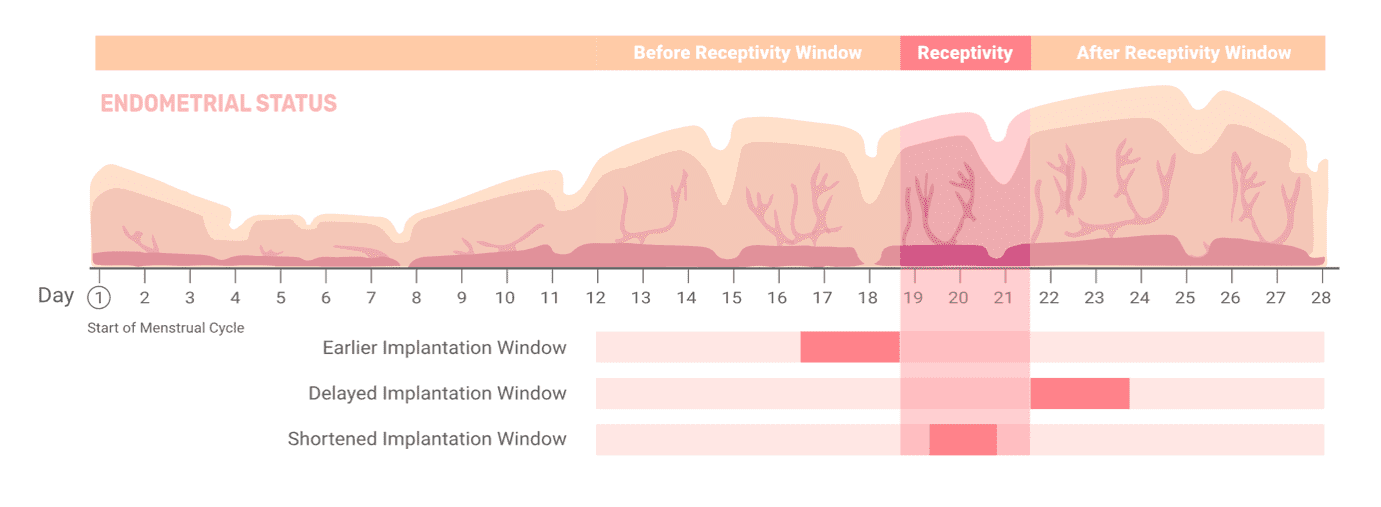MIRA™ is a microRNA-based genetic test that determines the best time for your embryo implantation, increasing your chances of getting pregnant through IVF treatment. This unique test analyzes your endometrial receptivity, delivering fast and reliable results. Using novel miRNA biomarkers, MIRA™ increases the IVF pregnancy rate to 70% among patients who have a history of implantation failure.
MIRA™
An miRNA-based receptivity test to help families time their embryo transfer

What is MIRA™?
What is endometrial receptivity?
Endometrial receptivity refers to the status of the endometrium in relation to its ability to accept an embryo for implantation. There is a window of 2 to 3 days around the middle of your menstrual cycle, when the mucus membrane lining the uterus, the endometrium, is at the ideal thickness and consistency for embryo implantation to happen. This interval of receptivity is commonly called the window of implantation (WOI).
How does MIRA™ help with the IVF treatment cycle?
Having inaccurate information about when your WOI occurs during your menstrual cycle is a leading cause of implantation failure. Large scale studies have shown that as many as 30% of patients seeking treatment for infertility have displaced WOIs. MIRA™ is able to assess your endometrial receptivity in order to determine the best time for embryo transfer.

What can MIRA™ tell you?
Once your biopsy sample has been analyzed, you and your fertility specialist will receive a comprehensive report detailing your optimal WOI and advising when to perform your personalized embryo transfer. The test will return one of three results:

PRE-RECEPTIVE
A pre-receptive test result means that your endometrial lining was not yet at peak receptivity at the time of biopsy, and your WOI is delayed. Your fertility doctor will schedule your embryo transfer accordingly.

RECEPTIVE
A receptive test result means your endometrial lining was at peak receptivity when you had your biopsy. Your fertility doctor will schedule your embryo transfer as normal.

POST-RECEPTIVE
A post-receptive test result means that your endometrial lining was past peak receptivity at the time of biopsy, and your WOI is earlier than average. Your fertility doctor will schedule your embryo transfer accordingly. In the case of a post-receptive result, we recommend testing a second time to account for the additional possibility of a shortened WOI.
Why should you choose MIRA™?
MIRA™ uses a less invasive biopsy procedure and reduces the margin of error through the use of microRNA (miRNA), a more stable and tolerant genetic material than messenger RNA (mRNA). This unique endometrial receptivity test delivers fast and reliable results using novel miRNA biomarkers to increase the IVF pregnancy rate to 70% among patients who have a history of implantation failure.
RELIABLE
MIRA™ provides actionable results in over 99% of first biopsies, so patients and healthcare providers can be confident that they’re getting the information they need in a timely manner.
SENSITIVE
MIRA™ can process smaller quantities and lower-quality tissue samples, meaning a less uncomfortable biopsy procedure for patients.
COMPREHENSIVE
MIRA™’s 100 miRNA biomarkers target over 600 endometrial receptivity-related genes to accurately identify the optimal time for embryo transfer.
Should you take this test?
A displaced WOI can happen to anyone, regardless of age. If any of the following situations apply to you, MIRA™ may be able to help:
- A history of implantation failure or miscarriage
- Few remaining high-quality embryos
- A thinner endometrium
- Age 35 or older*
*While all ages have the possibility of having a displaced window of implantation, recent data has shown that this is an increased possibility for patients 35 or older.